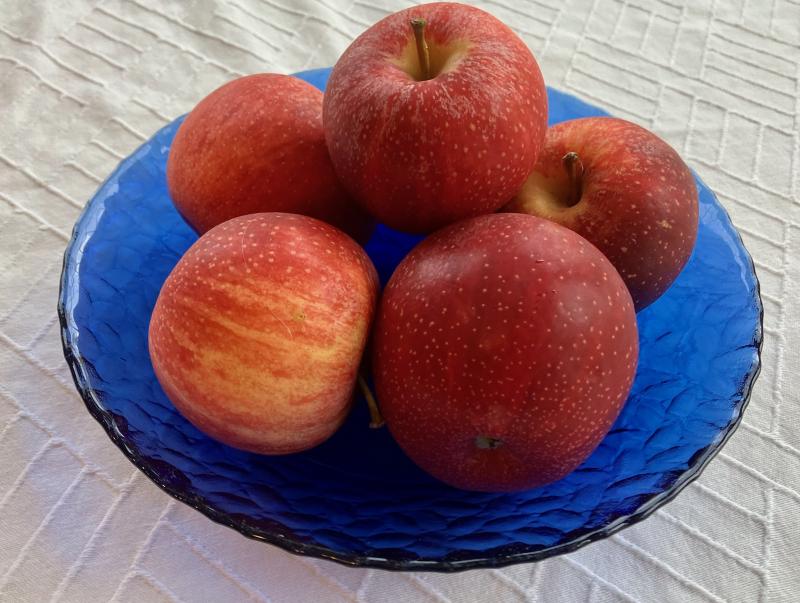Apples are abundant, so go ahead and get saucy
From farmers markets to supermarkets, apple varieties from Gala to Granny Smith are currently in abundant supply. Although apples can be found at the grocery throughout the year, this is the best time to enjoy fresh, crisp flavors from local growers. The cultivation of apples originated centuries ago in what is now Kazakhstan, where the name of the former capital city, Alma Ata, means “full of apples.” And, like many ancient crops, apples traveled through Asia and Europe to finally reach the New World.
Contrary to the legendary Johnny Appleseed, who preferred wild varieties, apples in most modern orchards aren’t grown from seeds, but cloned by grafting the desired cultivar onto root stock. If you have the patience, you could spend 10 years waiting for a seedling to mature and develop fruit. Just keep in mind the offspring (similar to humans) may have some resemblance to its parents, but with its own flavors and habits.
There were many accounts of Appleseed’s travels and plantings published during his lifetime. When he died, he left acreage with thousands of trees in Ohio and Indiana. Historians do not agree on which type should be called the “Johnny Appleseed” apple, but some believe it is similar to the Albemarle Pippin. According to Michael Pollan, these apples were not an edible variety and could be used only for making hard cider: “What Johnny Appleseed was doing was bringing the gift of alcohol to the frontier.”
Whether you’re making applesauce, apple butter, baked apples or apple pie, the variety you choose will make a difference in the result. First, be sure to select fruits with smooth skin, free of blemishes, nicks or soft spots. Store them in a cool, dark, airy place, arranged so they aren’t touching each other. If kept too long, apples will become dry, mealy and flavorless (although the deer who visit my backyard don’t seem to mind).
The apple varieties to avoid in cooked recipes are Red Delicious, McIntosh and Empire. These have soft, fine-grained flesh that doesn’t hold its shape. Instead, use them in salads and applesauce. Cortlands work well in salads because they don’t brown quickly when cut; they also stay firm when cooked, making them good for baking. Sweet varieties such as Fuji, Gala and Braeburn are best eaten raw.
Green-skinned, firm-fleshed and tart Granny Smith apples are one of the juiciest varieties, good for sautéing or simmering into applesauce. The versatile Golden Delicious (no relation to the Red Delicious) is ideal for cooking whole, since it retains its shape as its rich flavor intensifies.
When preparing your apples for certain recipes, make sure to have the right tools on hand. To remove the skin, use a vegetable peeler or paring knife. If you’re making apple rings or whole baked apples, remove the center seeds with a corer, basically a sharp, rounded blade that can excise the inedible interior.
For inspiration, there’s a bowl of lovely Gala apples in the photo. I’ve included recipes for basic applesauce, apple rings and a breakfast combination of apples sautéed with bacon which could also be served alongside pork tenderloin or chops.
Applesauce
6 C peeled, chopped apples
1/2 t lemon zest
1 cinnamon stick
1/3 C orange juice
Combine ingredients in a heavy pot. Cover and simmer, stirring occasionally until the apples are tender. Remove cover and cook over medium until thickened. If a smoother consistency is desired, remove cinnamon stick and purée in a food processor or with an immersion blender. Yield: 4 to 6 servings.
Apple Rings
2 large Golden Delicious apples
2 T butter
1/2 t cinnamon
3 T sugar
Core the apples and cut crosswise into slices 3/8-inch thick. Melt butter in a skillet and add as many slices as will fit in a single layer. Cook until the slices are golden on the bottom, about 3 minutes. Turn and cook until tender, another 3 or 4 minutes. Transfer to a platter. Once all the rings are cooked, combine cinnamon and sugar; sprinkle over rings. Yield: 4 servings.
Apple Bacon Sauté
4 large Rome Beauty apples
8 slices bacon
2 T brown sugar
Peel, core and cut the apples into half-inch pieces; set aside. Cook bacon in a large skillet until crisp. Remove bacon to a paper towel-lined plate; cover to keep warm. Discard all but 2 T of the bacon fat. Add apples to skillet and cook, stirring often until starting to brown, about 10 minutes. Crumble cooked bacon over apples and sprinkle with brown sugar. Yield: 4 servings.






















































